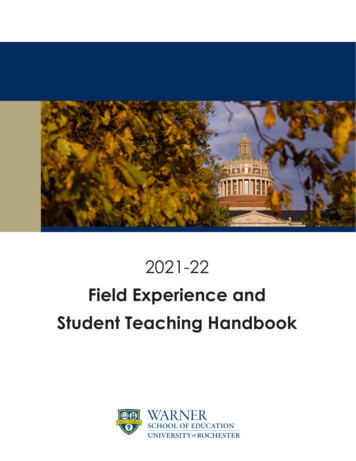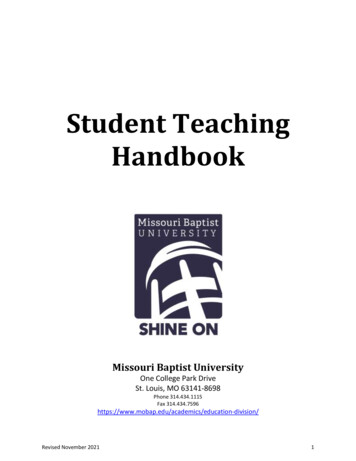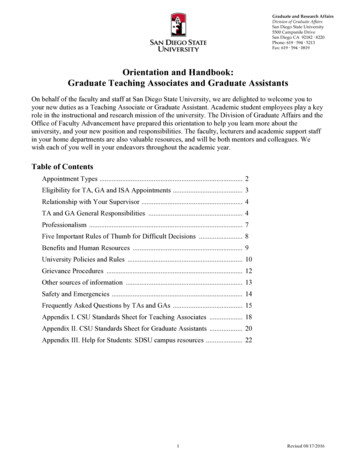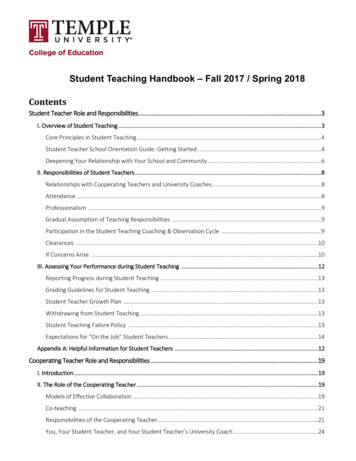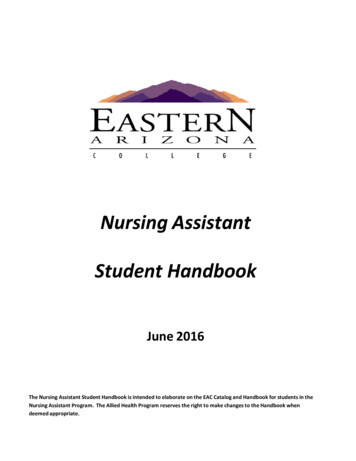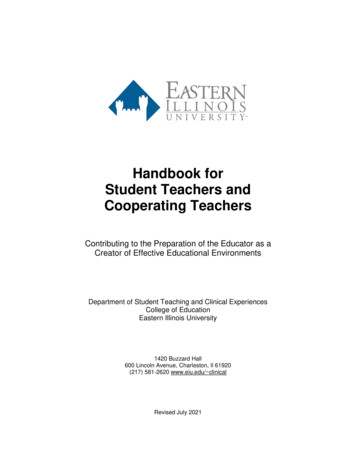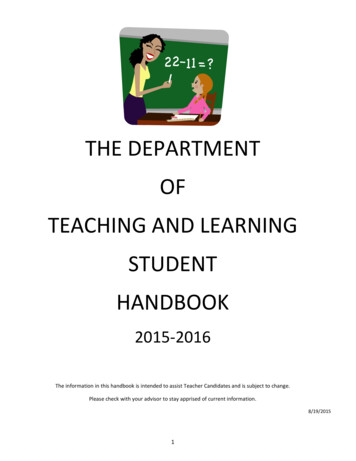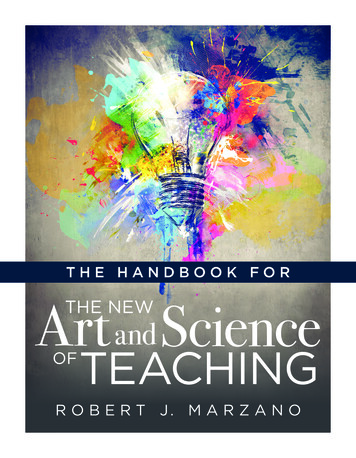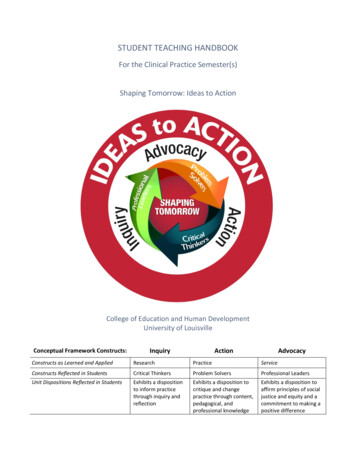
Transcription
STUDENT TEACHING HANDBOOKFor the Clinical Practice Semester(s)Shaping Tomorrow: Ideas to ActionCollege of Education and Human DevelopmentUniversity of LouisvilleConceptual Framework Constructs:InquiryActionAdvocacyConstructs as Learned and AppliedResearchPracticeServiceConstructs Reflected in StudentsCritical ThinkersProblem SolversProfessional LeadersUnit Dispositions Reflected in StudentsExhibits a dispositionto inform practicethrough inquiry andreflectionExhibits a disposition tocritique and changepractice through content,pedagogical, andprofessional knowledgeExhibits a disposition toaffirm principles of socialjustice and equity and acommitment to making apositive difference
TABLE OF CONTENTSIntroductionUniversity Mission StatementCollege of Education and Human Development Mission StatementConceptual Framework ConstructsIdeas to Action: UofL Developmental Teacher Preparation ModelOffice of Educator Development and Clinical Practice (OEDCP)OEDCP Contact Information4556PART I: POLICIES AND PROCEDURES141113Included are governing policies of the University of Louisville for student teaching.Purpose of Student Teaching15Approval for Student Teaching16Institutional Policies17Legal Issues Related to Student Teaching23Professional Liability Insurance Coverage24Professional Dispositions25Link to Teacher Candidate Dispositions Assessment26Performance Issues and Concerns27Link to Communication of Concern Template28Professional Code of Ethics31PART II: ROLES, RESPONSIBILITIES, AND RELATIONSHIPS33Professionalism34Correspondence and Communication352
Clinical Placement Support36Role of the Student Teacher38Role of the Cooperating Teacher44Tuition Benefit Eligibility50Role of the University Supervisor51Link to Steps to Completing a Formal Observation Document53PART III: LINKS TO TEMPLATES AND RUBRICS543
INTRODUCTIONThe Student Teaching Handbook serves as a guide to clinical policies and procedures,participant responsibilities, and an overview of the initial process of teacher certification andsubsequent readiness for employment as a professional educator. The handbook does notsupplant existing, specific program guides, but is rather a general compendium of practices withwhich all student teachers must comply to qualify for certification. Information containedherein should be useful to cooperating teachers and university supervisors as well, detailingexpectations of respective roles during the student teaching semester(s).For the student teacher candidate, this semester will afford both satisfying and challengingtimes. You will find P-12 students who are willing and eager to accept you as an instructor, andthose who will be difficult to reach. So, bear in mind that you have been preparing for theclinical semester, and it should be viewed as an opportunity for professional growth. Some daysin the classroom will be more challenging than others. Those will likely be the days when youwill seek greater input from cooperating teachers, other experienced teachers, or youruniversity supervisor. Remember the reasons that led to your conscious decision to work withstudents in a classroom setting, and learn from both the less successful as well as more positiveteaching experiences.To our school-based partners, we extend our sincere gratitude for participating in this jointventure as we partner in the final phase of preparation of our teacher candidates. Weappreciate your time and effort spent in helping to make our programs successful.University of LouisvilleCollege of Education and Human Development4
UNIVERSITY OF LOUISVILLE MISSION STATEMENTThe University of Louisville pursues excellence and inclusiveness in its work to educate andserve its community through:1. teaching diverse undergraduate, graduate, and professional students in order todevelop engaged citizens, leaders, and scholars;2. practicing and applying research, scholarship and creative activity; and3. providing engaged service and outreach that improve the quality of life for local andglobal communities.The University is committed to achieving preeminence as a nationally recognized metropolitanresearch university.As adopted by the Board of Trustees of the University of Louisville, January 14, out/mission-statement/MISSION OF THE COLLEGE OF EDUCATION AND HUMAN DEVELOPMENTThe College of Education and Human Development embraces the University's mission as ametropolitan research university committed to advancing the intellectual, cultural, andeconomic development of our diverse communities and citizens. We promote the highest levelsof learning and social, emotional, and physical health and well-being for all children, individuals,and families. Our programs enhance the organizations and communities in which they grow anddevelop.Our mission is to advance knowledge and understanding across our disciplines andconstituencies and to develop educational leaders who will inform policy, improve practice,strengthen communities, and address pressing social concerns. We prepare students to beexemplary professional practitioners and scholars; to generate, use, and disseminateknowledge about teaching, learning, health promotion and disease prevention, and leadershipin public and private sector organizations; and to collaborate with others to solve critical humanproblems in a diverse global community. We seek to continually improve the quality of life forall in our metropolitan community, the Commonwealth of Kentucky, and the nation.VISION OF THE COLLEGE OF EDUCATION AND HUMAN DEVELOPMENTOur vision for the College of Education and Human Development is to be a top-tier nationalMetropolitan College of Education in teaching, scholarship, and stewardship. We will respondto the needs of our constituents, including school districts, local agencies, and organizationsthat seek to advance education and human 5
CONCEPTUAL FRAMEWORK2015Shaping Tomorrow: Ideas to ActionShaping Tomorrow: Ideas to Action, the Conceptual Framework for the College of Educationand Human Development (CEHD) at the University of Louisville, incorporates the shared visionof various stakeholders, including our university, school, and community partners. OurConceptual Framework responds fully to the university’s commitment to service, diversity,equity, and social justice and is aligned with university, unit, state, and national standards, aswell as with UofL’s Quality Enhancement Plan for accreditation by the Southern Association ofColleges and Schools SACS).Construct 1: InquiryThe blend of practice and research at the university reaffirms my deeply heldbelief that worthwhile knowledge draws on both worlds. Indeed, the separationof practice from theory, of practitioners from scholars, is more often than not adivorce that is more symbolic than real. (Cuban, 1993, p. xxi)Under the construct of Inquiry, and through active engagement and skilled training in multiplemethods of rigorous Research, students in the CEHD develop the knowledge, skills, anddispositions to become Critical Thinkers. At the core of this Conceptual Framework is theconcept of the collegium, in which scholarship, the activity of knowledge-seeking, is performednot in isolation but in communion and solidarity with others, both within the academy and inthe world (Shulman, 2004b).The communal nature of the scholarly work of the CEHD is reflected in the processes ofgenerating, communicating, and questioning the results of research. We affirm that our workresponds to and thrives on the necessary and productive tensions between the domains ofpolicy, research, and professional practice. College research reflects the “disciplinedeclecticism” described by Shulman (2006). It is multidisciplinary and multi-method, asdemanded by our diverse programs and areas of interest. Our faculty and students activelyengage in the academic discourse of multiple professional disciplines; participate inprofessional societies and organizations related to their individual disciplines; and respond tothe local, state, and national policies that impact their professional practice and the processesof education in real schools. CEHD administrators and faculty respond to and promotestandards-based curricula in support of educational excellence. Graduates of our programsmeet rigorous standards of performance in teaching, leadership, school counseling, and otherprofessions. CEHD policy documents and assessment tools (Hallmark Assessments, Student6
Learning Outcomes, Academic Program Reviews, etc.) are continually revised and adapted toreflect changing local, state, and national standards of research-based best practice.Inquiry skills can be defined as “seeking knowledge to solve problems and to achieve goals”(Kuhn, 2005, p. 5). Others may define inquiry slightly differently, perhaps including in thedefinition the understanding of how knowledge is generated and justified and the use of thoseunderstandings to engage in new inquiry (National Research Council, 2005). The University ofLouisville’s Quality Enhancement Plan (QEP) for SACS accreditation, a critical thinking initiativefor improvement of undergraduate learning (see Section VI of this document), uses the PaulElder model for critical thinking, which defines critical thinking as “that mode of thinking—about any subject, content, or problem—in which the thinker improves the quality of his or herthinking by skillfully taking charge of the structures inherent in thinking and imposingintellectual standards upon them” (Paul-Elder, 2008). The CEHD’s Conceptual Frameworkendorses and incorporates the university’s critical thinking model. Our conception of inquiry,therefore, does not merely include the performance of the skills of inquiry but, rather,encompasses a candidate’s/student’s deeper understandings of how, when, and why to usesuch skills. We acknowledge that our students’ metacognitive abilities must be enhanced bystructured reflection and that this involvement is critical to independent inquiry.A cornerstone of inquiry is the idea of a thesis, or question, and the potential evidence thatsupports it. According to Paul (2007), a well-developed critical thinker is able to formulate vitalquestions and problems; gather, assess, and interpret relevant information; define and testsolutions; and think open-mindedly within alternative systems of thought. Further, Anderson(2001) claims that the most important aspect of critical thinking is that it is situational in nature.Critical thinking, like inquiry, includes both contextual performance skills and metacognitiveskills. Programs in the CEHD are designed to enhance both of these abilities in our students.Research is a structured medium through which good questions are asked and then answeredthrough the application of rigorous research design and analytical skills. Our students becomecritical thinkers, operationalizing, testing, and refining their inquiry skills in the real-worldlaboratories of schools and other educational institutions.Construct 2: ActionTeaching, at its best, means not only transmitting knowledge, buttransforming and extending it as well. . . . In the end, inspired teaching keepsthe flame of scholarship alive. (Boyer, 1990, p. 24).Under the construct of Action, and through routine, continual, and pervasive Practice—whether this be in the areas of pedagogy and instructional leadership, counseling, or research—students in the CEHD develop the knowledge, skills, and dispositions to become Problem7
Solvers in the community. They are encouraged to apply knowledge to solve real world andcommunity problems. Their work, and ours, manifests collaboration and signature partnershipswith others in the metropolitan region, the state, the nation, and outside the United States.Our students are challenged to test the knowledge they acquire through public performance, toshare what they have learned with peers and professors (Shulman, 2006), and to apply thisknowledge in multiple settings. Through the action of testing their knowledge in appliedcontexts each student is capable of becoming a teacher for many.Shulman’s categories of knowledge include knowledge of educational contexts, ranging fromthe workings of the group or classroom, to the governance and financing of school districts, tothe characteristics of communities and cultures (Norlander-Case, Reagan, & Case, 1999). Theknowledge of educational ends, purposes, and values (and the philosophical and historicalfoundations of these) is inherent to understanding that teaching occurs at the interaction ofcomplex disciplines with diverse and complex learners (Strong, 2002).Effective educators emphasize meaning, recognize that students are multifaceted individuals,and understand the relationship of ideas and experiences to learning in and out of classrooms(Duck, 2000f Hogan, Rabinowitz, & Craven, 2003f Shulman, 2000). CEHD students learn toconstruct knowledge through interpreting, analyzing, and evaluating. They draw conclusionsbased on understanding, make and support problem-based solutions, and connect learning toauthentic settings. The role of theory-to-practice connections in authentic teaching andlearning experiences has been found to have a significant impact on student achievement(Newmann, Bryk, & Nagaoka, 2001).Our students’ repertoires of research-based strategies are a key dimension of overalleducational effectiveness. In programmatic courses and experiences, students employ a rangeof strategies and develop and regularly integrate inquiry-based, hands-on learning activities,critical thinking skills, and assessments that reach all learners.Construct 3: AdvocacyScholarship should be promoted as zealously as though it were an end untoitself, but the final appraisal of scholarship should be, not its prestige withscholars, but its value to human life. (Albion Small, as cited in Shulman,2004a, p. 216)Under the construct of Advocacy and through dedicated, committed Service to their peers,university, community, and world, students in the CEHD develop the knowledge, skills, anddispositions to become Professional Leaders. Shulman (2006) notes that through practicetheoretical principles become commitments engraved on the heart. The CEHD exists in ametropolitan community and a world marked by diversity. Diversity has many dimensions,8
encompassing (among other things) ethnicity, gender, socioeconomic status, age, nationalorigin, English language proficiency, and exceptional ability. Our duty to promote diversityimplies that we empower our students and others to participate fully in the life of thecommunity in which we live, to practice social justice, and to seek equity of educational accessfor all the constituents we serve.Social justice serves as a framework for unifying the teaching and scholarship across disciplinesin the CEHD with the constructs of inquiry, action, and advocacy. As a college, we encompass awide array of research and instructional interests. Therefore, the conception of social justicethat guides us is both comprehensive (covering multiple dimensions suitable for an institutionwith a range of programs and a diverse student body) and specific (employing defined anddemonstrable understandings). As a collective unit and within individual departments anddisciplines, the CEHD furthers university and college-wide initiatives in order to build theknowledge, skills, efficacy, and urgency to address and solve community problems. Theintegration of social justice into our Conceptual Framework impacts educator practices, studentexperiences, and program policies (McDonald, 2005).As described in our Mission Statement, the CEHD is committed to honoring diversity andfurthering social justice, as reflected in our bio-ecological model of a democratic society. Equityand social justice compel us to use inquiry, action, and advocacy to deepen and extend theconstruct of democracy in our pluralistic society (Parker, 2003).Social justice affects our programs and is embedded in the work of faculty and students in twokey ways. First, we believe that our faculty and students/educator preparation candidates areresponsible for asking and answering important ideological questions regarding education forsocial justice. Cochran-Smith (2004) stated them thus: “What is the purpose of schooling, whatis the role of public education in a democratic society, and what historically has been the role ofschooling in maintaining or changing the economic and social structure of society?” (p. 144).Our faculty and students/candidates ask and answer these questions as they promoteknowledge in community through research, practice, and service. As contributing members to ademocratic society, our faculty and students/candidates build individual and collective capacitythrough their roles as teachers, counselors, instructional leaders, researchers, and members ofthe community.Second, we examine how social justice is contextualized in the communities connected to ourlives and work. The University of Louisville is a state-supported university located in ametropolitan area. The children and adults of our community face many challenges, includingsocial, economic, legal, and cultural barriers to education. Our commitment to social justicedemands that we seek to rigorously understand, investigate, and end these inequities. We arecommitted to the core assumptions of the Kentucky Educational Reform Act (KERA, 1990),9
which asserts that all children can learn, and Senate Bill 1, Unbridled Learning (2009), whichcalls for every child to reach his or her learning potential and to graduate from high schoolready for college and career. We are also committed to the Kentucky Council on PostsecondaryEducation’s vision that “all Kentuckians will be prepared to succeed in a global economy.” Toachieve these goals, we employ research-based pedagogical, counseling, and administrativepractices that encourage learning that is relevant, dynamic, and transformative.We believe that advocacy is a motivation for service and a support for change and that it isessential to strengthening a dynamic, democratic society. We demonstrate our commitment tosocial and human equity in our teaching, research, professional practices, relationships withothers, and actions undertaken outside the college.Opportunities for students to engage in leadership and collaboration extend across a range oforganizations served by the CEHD, including school districts, non-profit agencies, clinics,businesses, and community organizations. CEHD responds to the needs of the Jefferson CountyPublic Schools (JCPS), the largest public school district in the state, and the Ohio ValleyEducation Cooperative (OVEC), an educational consortium of thirteen counties surroundingLouisville. The CEHD participates in UofL’s Signature Partnership Initiative, which works toenhance the quality of life and economic opportunity for residents of West Louisville. Oursignature partnerships aim to eliminate disparities in education, health, economicdevelopment, and human/social services within the urban core through hands-on engagementin five schools in West Louisville (see Appendix D for information on the college’s work withProfessional Development Schools). Both educator preparation programs and humandevelopment programs maintain close relationships with local, state, and national associationsand agencies related to their individual disciplines and provide opportunities forstudents/candidates to collaborate with the community in real-world settings.Every course syllabus outlines for students the relationship of the course to the college’sConceptual Framework. Each course in the college also has a Hallmark Assessment Task (HAT)(a major course assignment developed by faculty specifically for the course and required ofevery student who takes the course). Data collected through student completion of the HATsupports the CEHD Unit Assessment System, which is based on the unit’s ConceptualFramework. In addition, all education preparation candidates are assessed on the ConceptualFramework at least once and possibly up to three times by their program using the Ideas toAction Holistic Construct rubric (see Appendix E).For complete text of the 2015 CEHD Conceptual Framework, including Appendices, click onceptual-framework2015.pdf10
OFFICE OF EDUCATOR DEVELOPMENT AND CLINICAL ementThe Office of Educator Development and Clinical Practice (OEDCP) at the University of Louisvilleis housed in the Raphael O. Nystrand Center of Excellence in Education. The Nystrand Center’spurpose is to develop, implement and study collaborative efforts to improve teaching. TheOEDCP facilitates field and clinical placements working with a variety of district and communitypartners, collects and organizes placement and assessment data, and ensures compliance tostate regulations which govern field and clinical experiences.Field Experience and Clinical Practice Placement PolicyThe Office Educator Development and Clinical Practice (OEDCP) places candidates in field andclinical placement sites that are aligned with the College of Education and HumanDevelopment’s mission statement and Conceptual Framework. Ideas to Action, our conceptualframework, is grounded in the notion that candidates become critical thinkers, problem solvers,and leaders through Inquiry, Action and Advocacy-all active qualities that require significantfield and clinical experiences. Each field and clinical experience is mapped to the ConceptualFramework and includes performance-based tasks that are assessed using rubrics that includecomponents from national, state and professional standards.Placement Sites Field and clinical placements are arranged in collaboration with establishedpartners, which include our two largest partners-Jefferson County Public Schools (JCPS) and theOhio Valley Educational Cooperative (OVEC), and Archdiocese of Louisville. The OEDCPcoordinates placements based on various factors, including state mandates, previousplacements and experiences, personal/work connections, experiences with diverse learners,career aspirations, and strengths and needs of the candidate as determined by the candidate,the university supervisor and/or faculty advisor. Candidates may indicate district preferencewhen completing the Student Teaching Application; however, all placements are contingent onidentifying a qualified mentor and university supervisor as well as consideration of the factorslisted above. For student teaching placements, outside of our regional area, candidates mustsubmit a written request to the OEDCP Placement Office.School districts recommend school sites based upon a number of factors including effectivementors and diverse student populations. The OEDCP is involved in regular and frequentcommunication concerning student placements with the JCPS Director of Human Resources,the JCPS Coordinator of Student Teachers; the OVEC Director of District Support and Director of11
Special Initiatives; and district and community leaders throughout the service region.Placement Procedure Field and clinical experiences represent a variety of early and ongoingschool- based and community-based opportunities, in which candidates work in classroomsettings to assist, tutor, instruct, conduct applied research, reflect and analyze under thedirection of a certified teacher or educational director. A Field Experience Placement Formcompleted by candidates provides information needed to secure the appropriate type ofplacement. The OEDCP tracks field hours via KFETS to ensure candidates have access to avariety of urban, suburban and/or rural settings and experiences with student populationsdiverse in cultural, economic, linguistic and special needsThe CEHD has formed a variety of partnerships. Elementary, middle and high schools have beendesignated as Early Professional Experience Sites, which allow candidates a first look at theteaching profession in an effective learning community. The CEHD has a number of designatedpartner schools in JCPS, OVEC, and the Archdiocese in which candidates and school personnelhave on-going and job embedded school and university support. The district and schoolleadership work in concert with the OEDCP and CEHD Program Directors to place candidateswith educators in these schools. District/university supported grants have opened up avenuesto expand the clinical model.The OEDCP officially requests placements by contacting a designated administrator at eachdistrict- approved site. The request may specify a particular educator(s) or ask for anadministrator recommendation using agreed upon selection criteria. A brief description andpurpose of the field experience, the number of field hours required, the description ofcandidate activities and the role of the cooperating teacher is provided.Once a candidate placement is confirmed, school administrators and mentor/cooperatingteachers are notified through email of the placement with a more detailed description of rolesand responsibilities. The school contact person is provided a list of all candidates assigned tothat site. For clinical placements, a Cooperating Teacher Training/Orientation is offered whichprovide state mandated content. Candidates are notified of their placements and theexpectations for the field and clinical assignment through their course instructor, universitysupervisor and/or OEDCP personnel.Diversity in Clinical PracticeDiversity is a shared vision for our efforts in preparing teachers, administrators, schoolcounselors and other professionals. In order to foster perspectives consistent with this vision,12
candidates investigate and gain a current perspective of diversity issues (race, ethnicity,language, religion, culture, SES, gender, gender identity, sexual orientation, military status,disability, ability, age, national origin, geographic location) through clinical practice.CONTACTSThe Office of Educator Development and Clinical Practice cementCody Windhorst, Director of the OEDCPcody.hinton@louisville.edu502-852-6412Room 259Robin Lipsey, OEDCP Middle and Secondary Education Field Placement Room 291Joshua Cloudy, Graduate Assistant to the OEDCP (assistance with EDTP 201, EDTP 107; generalinformation)joshua.cloudy@louisville.edu Room 255Denise Townsend, Assessment Coordinator, Academic Affairs & Unit Effectiveness (assistancewith KFETS, LiveText)denise.townsend@louisville.edu; livetext@louisville.edu502-852-3231Room 26113
PART I: POLICIES AND PROCEDURESIncluded are governing policies of the University of Louisville for student teaching.Purpose of Student Teaching15Approval for Student Teaching16Institutional Policies17Legal Issues Related to Student Teaching23Professional Liability Insurance Coverage24Professional Dispositions25Link to Teacher Candidate Dispositions Assessment26Performance Issues and Concerns27Link to Communication of Concern Template28Professional Code of Ethics3114
PURPOSE OF STUDENT TEACHINGClinical experiences are designed to familiarize candidates with various contexts andcomponents of the education process. Understanding classroom demeanor, policies of stateand district institutions, and other school-related issues help to ensure a student-focusedinstructor who can create a meaningful learning environment.The student teaching experience allows for demonstration of skills acquired in previousplacements, and encourages extension of these abilities as candidates apply educationaltheories and methodologies required for certification eligibility. The student teacher works withone or more cooperating teachers and a university supervisor.Student teachers will have opportunities to: Apply knowledge constructed during initial phases of the Teacher Education Program Employ methods and materials that engage all learners and that are research-based Develop school community interpretive skills Refine a personal teaching philosophy Learn curricular expectations Demonstrate understanding and proficiency of Kentucky’s Teacher StandardsTo meet regulatory requirements outlined in 16 KAR 5:040, student teachers shall haveopportunities to: Engage in extended co-teaching experiences with an experienced teacher; Engage in reflective self-assessment that informs practice; Maintain regular professional conversations with experienced teachers other than thecooperating teacher; Participate in regular and extracurricular school activities; Participate in professional decision making; and Engage in collegial interaction and peer review with other student teachers15
APPROVAL FOR STUDENT TEACHINGEach department determines the final eligibility to student teach. Art Education, EarlyChildhood and Elementary Education (ECEE), Health and Sport Sciences (HSS), Middle andSecondary Education (MISE), Music Education (MUED), and Special Education (SPED). Teachercandidates approved for student teaching shall have: Been admitted to the Teacher Education Program Completed the required professional courses Demonstrated satisfactory grades/progress as stipulated on individual program sheets Received required teaching dispositions as indicated on the Dispositions Assessment Demonstrated required progress on mid-point key assessments Completed and documented a minimum or 200 clock hours of field experiences andsubmitted into KFETS and LIVETEXT. Completed student teaching application requirements (placement form, medical/TB ifrequired by the district; criminal background check, handbook verification, Child Abuseand Neglect Check (CAN), and other district requirements) Completed Promoting Positive Behavior in Schools Training (PPBIS) Participated in Student Teaching Orientation16
INSTITUTIONAL POLICIESPer Kentucky Edu
The Student Teaching Handbook serves as a guide to clinical policies and procedures, participant responsibilities, and an overview of the initial process of teacher certification and subseq
